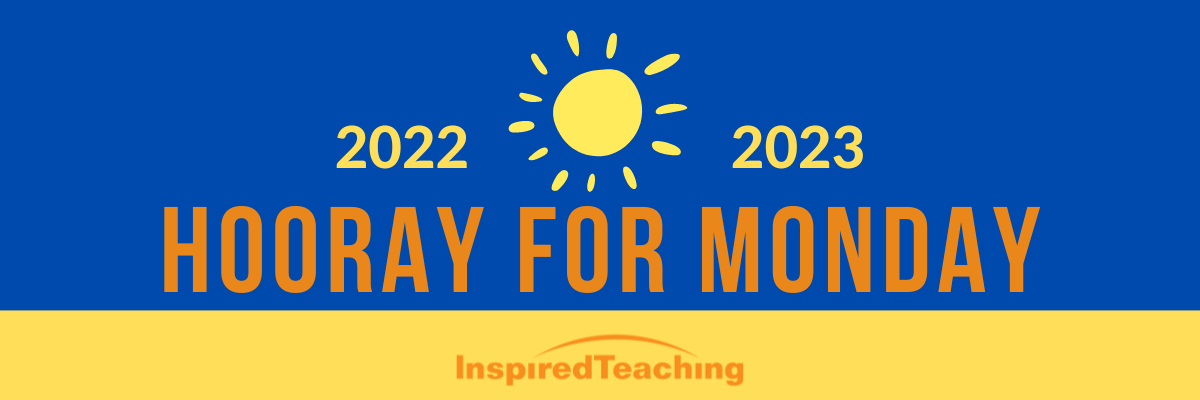March 6, 2023
By Aleta Margolis, Founder and President of Center for Inspired Teaching
Hooray for Monday is a weekly blog filled with questions, ideas, reflections, and actions we can all take to remodel the school experience for students.
You can now listen to Hooray for Monday on Spotify! Check out our podcast here.
In last week’s Hooray For Monday, we shared concrete strategies to increase school connectedness; and we received an unprecedented response from so many of you. You let us know that you are concerned about the young people in your care and that you are looking for more ways to connect with them. So this week, we’re sharing a tried and true Inspired Teaching activity that builds positive teacher-student relationships. It is built on a simple but essential instruction:
Let curiosity be your guide.

When you are worried for, frustrated with, or even feeling just fine about your students, curiosity is essential to understanding them, and keeping your relationship with them strong. At Inspired Teaching, we start our yearlong programs with an activity called “Sunshine vs. Up-at-Night Students” which is designed to help you focus on specific members of your classroom in order to better meet the needs of the class as a whole. Starting with just 7 reflection prompts, you do a deep dive into what you know about a student who brings you delight on a daily basis – your sunshine student, and one who keeps you worrying way past the end of the day – your up-at-night student. Here are the prompts:
- What does this student like?
- What does this student dislike?
- What are this student’s aspirations?
- What are this student’s contributions?
- Describe a situation in which you’ve seen this student succeed.
- Describe a situation in which you’ve seen this student really struggle.
- Describe any specific problems you are having with this student. What have you already tried?

When my colleagues and I work with teachers over a length of time, we come back to these initial reflections throughout the year. This helps teachers recognize how their growing knowledge about their students provides more insight into how to help them learn. If you try this approach, we recommend this regular revisit as well.

The students you choose at first for this activity are typically the ones that get the most of your attention. Extending the activity to other students in your classroom helps you deepen relationships with all your students. Humans thrive on being seen and heard, so this activity pushes us to think of new ways to see and hear our students.
Engaging with these 7 prompts creates new habits. It’s a tool for teaching your brain to respond to worry, frustration, and the like with curiosity. Curiosity is the opposite of panic; defensiveness; jumping to conclusions; and apathy – and curiosity is a wise starting place for increasing school connectedness and supporting students.
Wishing you a week of productive engagement, with sunshine and up-at-night students alike!
What We’re Curious About
Each week a member of the Inspired Teaching community shares something that’s currently piquing their curiosity. Maybe it will spark yours too!

String Theory
Michelle Welk, Communications and Marketing Specialist
As a non-physicist, string theory is a really abstract concept for me. But I do know that it suggests the existence of infinite, concurrent, universes. And that is really interesting. I’ve always wondered about the possibility of multiple Michelles, existing in timelines where I made different choices throughout life. After watching the movie “Everything, Everywhere, All at Once” recently, I’m fascinated by the idea of interacting with the versions of myself that took those different paths.
While we aren’t yet capable of jumping between universes, as Michelle Yeoh’s character does in the film, I wonder what else might be possible if I opened myself up to the choices I’d previously thought were already decided? What might it look like if we woke up each day with the knowledge that even the most mundane of choices we make have the ability to alter our lives in infinite ways? Do we really need proof that alternate universes exist to think more deeply about our own?
Teacher Resources
 Sunshine vs. Up-At-Night Student Reflection Sheet
Sunshine vs. Up-At-Night Student Reflection Sheet
These pages offer space for reflection on the questions posed in the post above. You might use these with a group of colleagues and share and discuss what you've written. Then come back together in a few months to see how your observations have changed!
 Finding the Zone of Proximal Development
Finding the Zone of Proximal Development
Helping your students identify their own strengths and areas for growth benefits them, and you as well. This activity introduces Lev Vygotsky and his construct, the zone of proximal development and offers a good space for learning about productive struggle.
 What would make you look forward to coming to school?
What would make you look forward to coming to school?
As we head into the final stretch of the school year, it can be challenging to hold students' attention and maintain those connections we've been working to make. This activity will create some student-generated solutions to that problem!




